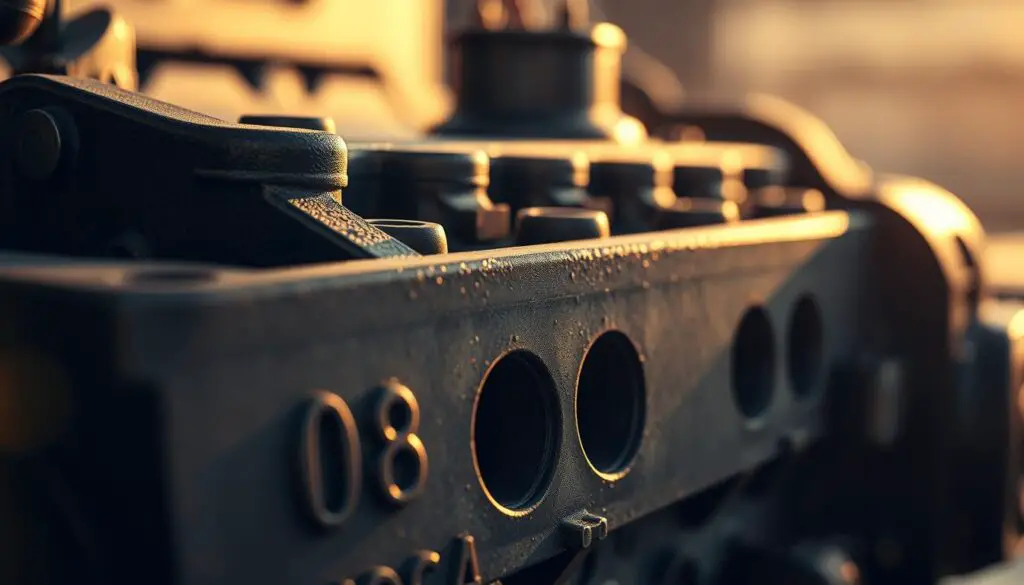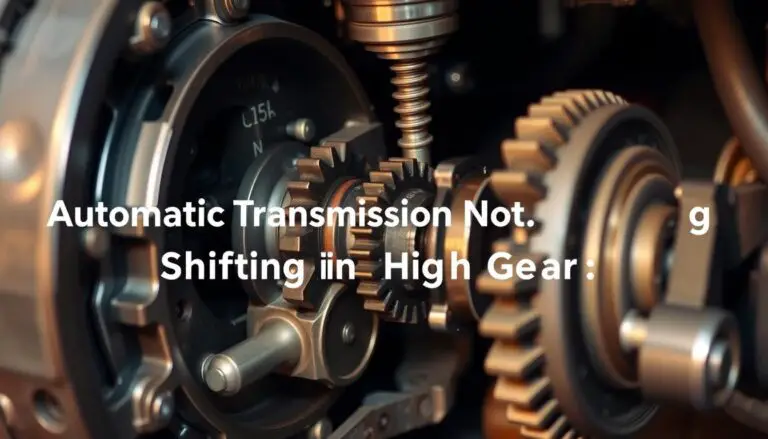This guide shows how to find and read small block identifiers so you can trace an engine’s history and verify originality for your car or truck.
The casting number sits on the rear driver-side of the block, while the engine ID stamping is hand-marked on the front passenger-side pad. Both marks matter when you want to confirm displacement, 2- vs 4-bolt mains, and original assembly details.
Suffix codes, month letters, and partial VINs on 1968-up units unlock the assembly line application, horsepower, and transmission pairing. Special items like CE service blocks or Goodwrench crate castings can look different, but they still offer useful production information.
Follow this article for step-by-step locations, decoding tips, trusted references, and real-world examples that help separate period-correct castings from later swaps.
Key Takeaways
- Locate the casting on the rear driver-side and the ID pad on the front passenger-side.
- Use suffix codes and month letters to confirm assembly date and application.
- Partial VINs (1968+) help prove numbers-matching restorations.
- CE and crate castings require different interpretation but still provide value.
- Cross-check findings with Mortec, NastyZ28, The Lime Book, and GM parts lookups.
- Decoding protects value by revealing swaps and verifying originality.
What This How-To Covers and Why Your Chevy Engine’s Numbers Matter
Follow a simple workflow that turns stamped data into actionable verification for any small block. This guide covers the full identification stack so you can authenticate a car or truck quickly and with confidence.
We examine rear and front marks, casting numbers, assembly date letters, the engine ID stamp, and suffix code details. You’ll learn what each code tells you: displacement, 2- vs 4-bolt mains, plant prefix, and original application.
Why it matters: a period-correct small block raises resale value and guides restoration choices. A swapped or service replacement can change fitment and performance claims, so reading the marks saves time and prevents costly mistakes at sale or swap meets.
- Scope: casting dates, engine ID stampings, suffix decoding, and partial VIN checks.
- What you learn: which codes show plant, assembly date, and application data.
- Workflow: locate, clean, record, cross‑reference with Mortec, NastyZ28, and The Lime Book.

Where to Find the Numbers on a GM Small Block
Start your inspection at the rear driver-side face of the block. The raised block casting and the adjacent date are usually visible there. This is the quickest spot to confirm core identity on an assembled car or truck.
Rear driver-side block casting number and casting date
Clean the rear area gently to reveal the raised information. Look for a short string and a nearby letter/number date that shows when the casting left the foundry.
Front passenger-side pad: engine ID stamping and suffix code
The flat pad in front of the passenger-side cylinder head holds the engine ID stamping and suffix code. On many 1968-and-newer small blocks you’ll also see a partial VIN near that pad.
Other locations: partial VIN, passenger side stampings, big-block and inline-six variations
Big block units may use the same pad or a stamp above the timing cover. Inline-six blocks commonly stamp behind the distributor on the passenger side. Grime, oil, or an alternator can hide marks—use light, a mild degreaser, and a soft brush.
- Record every character exactly; a missed space changes the meaning.
- Note main caps and bolt style to infer 2- vs 4-bolt mains.
- Photograph the cylinder head ends and pads while you can.
GM 350 Block Casting Numbers: Decoding Engine Origins
Begin by noting the raised casting string at the rear driver face; it tells you which displacements and main-cap styles that block commonly used.
Reading the block casting number
The casting helps you narrow displacement and whether the block typically shipped with 2- or 4-bolt main caps. Some small block castings show up across cars and trucks and in multiple years, so a single casting alone rarely seals the deal.
High-profile examples like 3956618 and 3970010 appeared in varied applications. That means you must cross-check other stamps and dates to pin model year and use.
Decoding casting date codes
Letters A–L represent months, followed by day and a year digit. Treat single-digit years carefully and verify decade with other identifiers.
Understanding the engine ID code
The front pad stamp uses a plant prefix, a four-digit assembly date (MMDD), and an engine suffix. Use published suffix tables to map the suffix to application and output.
Using the partial VIN
Many 1968-and-up units include a partial VIN. For model year confirmation, check the VIN position used in that era and align it with the casting date and suffix for a confident match.
| Casting Example | Typical Main Caps | Common Applications | Notes |
|---|---|---|---|
| 3956618 | 2- or 4-bolt | Small block cars, Z/28 variants | Cross-check suffix and date for exact year |
| 3970010 | 2-bolt | Performance small block fits | Found in multiple model years |
| Other small block casting | Varies | Cars and trucks | Confirm with pad stamping and partial VIN |
Verify What You Have: Cross-Referencing Codes with Real-World Examples
Cross-referencing pad stamps with component dates quickly separates period-correct cores from later swaps. Use suffix codes, crank castings, head dates, and main cap style together to build the picture.
Case study: a teardown revealed casting 3956618 on the block with an “HN” suffix on the pad, a cast-iron crank 3932442 (3.48-inch stroke), and a block date of B209 (Feb 20, 1969).
The heads (3927186) carried dates B189 and A239 and the intake (3927184) matches a 1969 Q-jet application. Two-bolt main caps were present, so the parts collectively point to a 1969 350/300 hp small block for that car or truck.
- Confirm stroke via the crank to rule out 327 or 302 uses.
- Match pad suffix and part dates to resolve duplicate suffix usages across years.
- Note accessories: a later water pump shows service history, not a full swap.
Compare this pattern to service crate examples (10036033, 10066036) or later Vortec-era castings like 10243880 to spot era differences. For value checks on two-bolt cores consult a short guide to a two-bolt main block value at two-bolt main block value.
Special Cases, Pitfalls, and Performance Clues
Special cases often hide in plain sight — service replacements and later crate units can mimic original parts.
CE-stamped service blocks and Goodwrench identifiers are legitimate replacement cores. They usually do not map to a single factory application, but they still give reliable casting and specification information for a car or truck.
Expect some later replacements to carry “Hecho en Mexico” or liter markings like 5.0L/5.7L. Those marks tell you the unit is a service or crate item rather than an assembly-line original.
Spotting small block vs big block cues
Distinguish small block from big block by external size, accessory mounting, and stamp location. Big blocks sometimes use a pad above the timing cover while inline-sixes stamp behind the distributor on the passenger side.
Viewing obstacles and worn stampings
An alternator, grime, paint, or oil can hide the front pad. Plan to clean gently and consider removing obstructing accessories to avoid damaging the surface.
Worn or shallow stampings are common after decades of use. If the pad is unclear, verify cylinder, head, and accessory castings for matching dates and codes before concluding.
| Clue | What it means | Action |
|---|---|---|
| CE / Goodwrench | Service / crate replacement | Note as legit replacement; cross-check specs |
| “Hecho en Mexico” / liters | Later service castings | Mark as non‑original for restoration records |
| Externally weighted balancer | 400 small blocks use external balance | Use balancer as a quick performance clue |
- Document everything: record every date, pad stamp, and suffix so you can revisit with better light or tools.
- Don’t rely on rumors: only pad stamps, casting matches, and supporting dates back an identification claim for a car or truck.
Your Step-by-Step How-To Workflow and Trusted Resources
Quick intro: Follow a simple, repeatable workflow to confirm a block’s provenance and avoid costly mistakes when buying or restoring a car or truck.
Hands-on workflow: locate, clean, record, decode, and confirm
Locate the rear driver-side raised number and the front passenger pad for the stamped ID and suffix. Check for a partial VIN on 1968-up cars and trucks.
Clean gently with degreaser and a soft brush. Use steady light and avoid scraping machined surfaces so you don’t damage the pad or bolt heads.
Record every letter, digit, and space exactly. Photograph the pad, rear face, heads, crank, and main caps for your file.
Decode in order: casting number first (to infer displacement and 2- vs 4-bolt), then the casting date (month letter A–L, day, year), and finally the pad code and engine suffix to lock down application.
Confirm by cross-checking the partial VIN and model year logic, and by comparing head, crank, and main cap dates to spot swaps or rebuilds.
Reference hubs
- Mortec: casting lists and casting date tables.
- NastyZ28: pad code decoders and suffix lookup.
- The Lime Book: deep suffix tables for 1955–1991 models.
- SS396 / VIN tools: partial VIN and model year confirmation.
- GM parts VIN lookup: assembly and production option checks (1960–2020).
Documenting findings
Create a concise report for swap meets, restorations, or performance builds. Include photos, transcribed data, and references used so buyers or builders can trust the provenance.
| Resource | Primary use | Best for |
|---|---|---|
| Mortec | Cast lists / dates | Verifying casting date and core fit |
| NastyZ28 | Pad decoders | Suffix code mapping and pad interpretation |
| The Lime Book | Suffix depth | Historic suffix cross-references (1955–1991) |
| SS396 / VIN tools | Partial VIN checks | Model year and option confirmation |
| GM Parts VIN lookup | Assembly/production data | Parts match and factory options (1960–2020) |
Conclusion
Wrap up with a clear verification pass. Match the rear driver-side casting string, the front passenger pad stamp, and any partial VIN to lock in the block’s identity.
Cross-reference with Mortec, NastyZ28, and The Lime Book to turn raw codes into a reliable model and year result. Note service markers like CE or “Hecho en Mexico” as legitimate replacement cores.
Record photos, transcribe every number and date exactly, and check bolt style and part dates. A final look at the pad and rear face prevents transcription errors and helps guide correct performance parts and restoration choices for your car or truck.
FAQ
Where exactly are the casting numbers and ID codes located on a Chevy small-block?
On most Chevrolet small-blocks you’ll find the main casting number on the rear driver-side of the block, near the bellhousing flange. The casting date often sits beside that number. The front passenger-side pad typically carries the engine ID stamping and suffix code. Some blocks also show partial VIN or additional stampings on the passenger side near the cylinder head rail.
How do I read a casting date code with month letters and day numbers?
Casting date codes use a letter A through L for months (A = January), followed by a one- or two-digit day and a year digit. For example, C15 8 might mean March 15, 1968, when aligned with other block details. Always cross-check with other stamps and parts to avoid misinterpretation.
What does the engine suffix code tell me?
The suffix code identifies the original application — transmission type, accessories, and horsepower variant. It also contains an assembly plant prefix and often an internal sequence number. Use factory suffix lists or reliable reference hubs to decode exact equipment and vehicle fitment.
How can partial VIN digits on the block confirm originality?
A block partial VIN or model-year digit can confirm the engine’s match to a vehicle if it aligns with the car’s VIN and production period. Compare dates, suffix codes, and head or crank numbers to ensure consistency. A mismatch may indicate an engine transplant or later rebuild.
What common casting numbers indicate period-correct Chevy small-blocks?
Frequently seen period-correct numbers include blocks like 3956618 and 3970010 for specific late-’60s and early-’70s applications. Vortec-era blocks and Goodwrench crate units carry their own distinct numbers and stampings. Always verify with a parts lookup or authoritative reference.
How do heads, crankshaft numbers, and main caps help corroborate a block code?
Matching head casting numbers, crankshaft stampings, and original main cap tags can confirm an engine’s original assembly and spec. These components often share production timelines and suffix correlations that, together, establish authenticity or reveal rebuilds.
What are the telltale signs of service or crate engines versus original production blocks?
Service or crate engines often carry CE or Goodwrench stampings, and late-production castings may read “Hecho en Mexico.” They might lack period suffix matches or have modern machining marks. Check assembly dates and vendor tags to identify replacements or reman units.
How do I handle obstructed or worn stampings when trying to read numbers?
Remove obstructing components like the alternator where safe, clean grime with a noncaustic degreaser, and gently use a brass brush to reveal numbers. Light raking with a flashlight and angled mirrors helps. If numbers remain unreadable, professional cleaning or magnaflux inspection may help.
What differences should I note between small-block and big-block casting cues?
Big-blocks are larger with different pad locations and heavier main caps. Casting number styles and placement vary by family; inline-six blocks also use different stamping patterns. Learn family-specific layouts before drawing conclusions from a single mark.
Which online and printed resources reliably help decode casting and suffix codes?
Trusted references include Mortec, The Lime Book, NastyZ28 forums, SS396 VIN tools, and official GM parts lookups. Factory service manuals and period parts catalogs also provide authoritative cross-references for suffixes, casting numbers, and assembly codes.
What is a practical step-by-step workflow for verifying a block’s origin?
Locate each stamping, clean and photograph them, record casting numbers, date codes, and suffixes, then decode using reputable references. Cross-check with cylinder heads, crank numbers, and the vehicle VIN. Document findings for resale, restoration, or performance planning.
Are there common pitfalls to avoid when decoding casting numbers?
Avoid assuming a single stamping confirms originality. Beware of swapped blocks, replaced heads, or re-stamped dates. Misreads happen when dirt, oil, or factory machining blur characters. Always corroborate with multiple data points before concluding.


